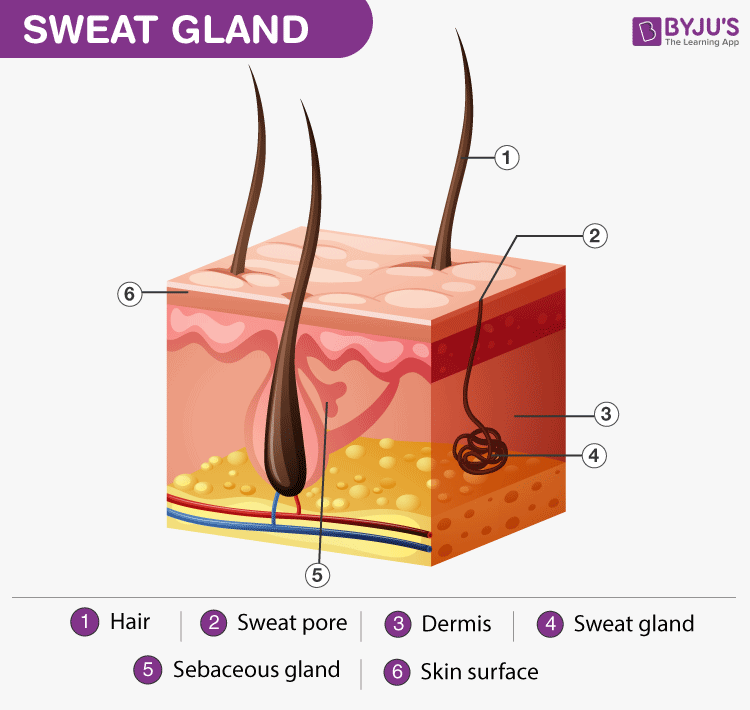Table of Contents
Introduction & Definition
Small tubular skin structures called sweat glands, also called sudoriparous or sudoriferous glands, are responsible for producing sweat.
Exocrine glands are found all over the surface of the body and are responsible for sweat production. The integument’s appendages are the sweat glands. There are apocrine and eccrine sweat glands. They vary in distribution, embryology, and function.
Most of the body is covered in thin skin with sweat glands, hair arrector muscles, hair follicles, and sebaceous glands. Simple, curled, tubular glands known as eccrine sweat glands are found all over the body, although they are most prominent on the bottoms of the feet.
The production of foul-smelling perspiration is a characteristic of apocrine sweat glands, also known as odoriferous sweat glands.
Structure
Typically, sweat glands consist of a secretory unit found in the subcutaneous tissue or deep dermis and a duct that extends from the secretory unit to the body surface through which sweat or other secretory products are delivered.
The gland is entirely encircled by adipose tissue, and the secretory coil or base is deeply embedded in the lower dermis and hypodermis. The contractile myoepithelial cells surrounding the secretory coils in both types of sweat glands facilitate the excretion of secretory contents.
The autonomic nervous system and the circulating hormones regulate the secretory activities of epithelial cells and the contractions of myoepithelial cells. The acrosyringium refers to the distal or apical portion of the duct that opens to the surface of the skin.
Numerous nerve fibres enter each sweat gland, branch off into groups of one or more axons and encircle each tubule of the secretory coil. Sweat tubules are connected by capillaries.

Types and Functions
Eccrine
There are eccrine sweat glands throughout the body, except few places such as ear canal, lips, etc. They are ten times less smaller than apocrine sweat glands, do not penetrate the dermis as profoundly, and secrete directly onto the skin’s surface.
Sweat, often known as sensible perspiration, is the transparent secretion generated by eccrine sweat glands. Since sweat is derived from blood plasma, it primarily contains water and some electrolytes. Sweat has a salty taste because it contains sodium chloride.
There are three primary functions of eccrine glands:
- Thermoregulation: Sweat lowers body temperature by cooling the skin’s surface via evaporation and evaporative heat loss.
- Excretion: The secretion of eccrine sweat glands can be an essential pathway for eliminating electrolytes and water.
- Protection: Eccrine sweat gland secretion contributes to maintaining the acid layer of the skin, which helps guard against bacterial and other harmful organisms invading the skin.
Apocrine
Apocrine glands produce sweat into the hair follicle’s pilary canal rather than directly onto the skin’s surface. There are apocrine sweat glands in the armpit, areola, perineum, ear, and eyelids. Compared to eccrine glands, the secretory area is more significant.
The apocrine sweat glands are dormant before puberty; hormonal changes during puberty lead the glands to enlarge and start functioning. Thicker than eccrine sweat, the produced component feeds the bacteria living on the skin.
Apoeccrine
Some human sweat glands, known as apoeccrine glands, exhibit traits that make them difficult to identify as either eccrine or apocrine. They are smaller than apocrine but larger than eccrine glands. Their secretory component has a large segment, like apocrine glands, and a narrow section resembling secretory coils in eccrine glands.
Apoeccrine glands are essential in axillary sweating because they secrete more sweat than eccrine and apocrine glands combined. They consistently produce a thin, watery sweat, like eccrine glands.
The elimination of particular excretory wastes is facilitated by sweat, even though its primary purpose is to assist in producing a cooling effect on the skin’s surface. The sweat glands secrete watery fluid in perspiration, containing minor amounts of urea, lactic acid, and other substances. Certain toxins can be removed from the body through the sebaceous and sweat glands in the skin.
Related Links:
Main Page: BYJU’S NEET
Comments